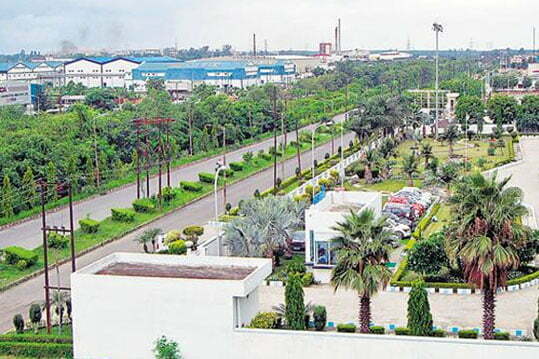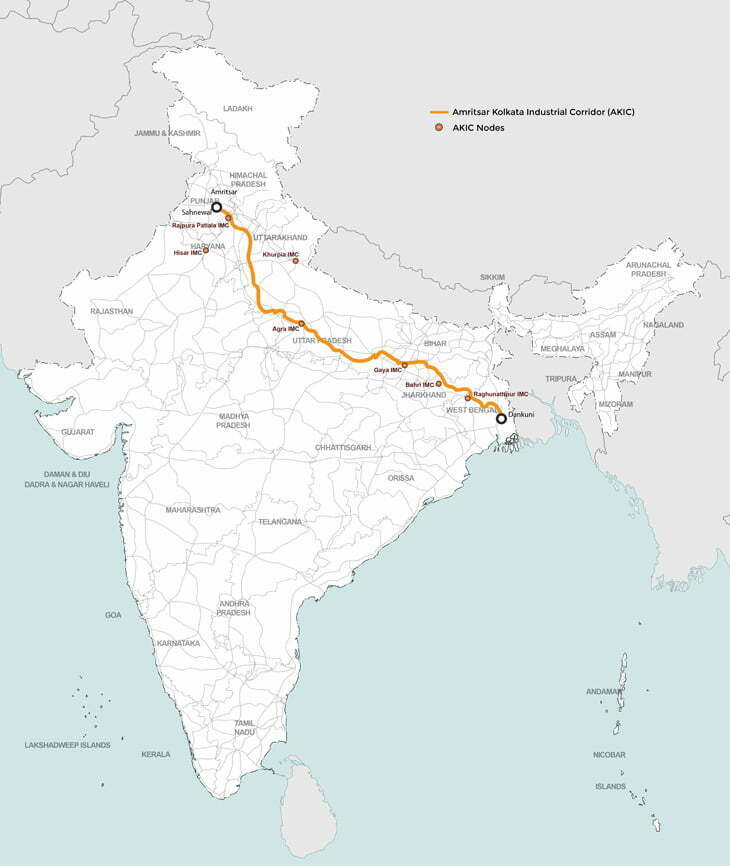
The Amritsar-Kolkata Industrial Corridor (AKIC) is one of India’s most ambitious infrastructure initiatives, aimed at revitalizing the manufacturing and industrial sectors across key regions in northern and eastern India. Spanning approximately 1,839 kilometers, this corridor links Punjab to West Bengal, covering seven Indian states—Punjab, Haryana, Uttar Pradesh, Uttarakhand, Bihar, Jharkhand, and West Bengal. It follows the alignment of the Eastern Dedicated Freight Corridor (EDFC) and aims to develop an industrial zone within a 150-200 km band on either side of the freight corridor.
Objectives and Vision
The primary objective of AKIC is to harness the economic potential of these regions by promoting investments in manufacturing, agro-processing, export-oriented industries, and services. It aims to create world-class infrastructure that will spur industrial growth, foster employment, and optimize the region’s economic output. By leveraging the EDFC, AKIC seeks to integrate these regions into a global supply chain, thus making them more competitive on both national and international platforms.
Industrial Clusters and Development Nodes
AKIC is designed to develop industrial hubs or Integrated Manufacturing Clusters (IMCs) across various locations, fostering regional synergies and providing a significant boost to the local economy. Each of these clusters will serve as key manufacturing bases, enabling industries to thrive by providing them with sustainable infrastructure and efficient logistics.
Key IMCs identified for development include:
- Hisar Integrated Manufacturing Cluster (IMC), Haryana – Spread over 2,988 acres
- Prag Khurpia IMC, Uttarakhand – 1,002 acres
- Rajpura-Patiala IMC, Punjab – 1,100 acres
- IMC at Agra and Saraswati Hi-Tech City, Prayagraj, Uttar Pradesh – 1,059 and 1,141 acres, respectively
- IMC at Gaya, Bihar – 1,600 acres
These clusters will provide the necessary industrial infrastructure to attract both domestic and international investments in various sectors, including manufacturing, agro-processing, textiles, and export-oriented industries.
Infrastructure and Connectivity
One of the standout features of the AKIC is its alignment with the Eastern Dedicated Freight Corridor (EDFC), which acts as the corridor’s backbone. This dedicated freight corridor ensures efficient cargo movement between northern and eastern India, significantly reducing logistics costs for businesses along the corridor. High-speed rail and road connectivity, combined with state-of-the-art logistics infrastructure, will enable industries to efficiently move goods, leading to an increase in exports and reduced turnaround times.
Additionally, the corridor will promote the development of complementary infrastructure such as:
- Logistics hubs
- Industrial parks
- Knowledge parks
- Smart cities
These investments in infrastructure will also result in significant job creation, improving employment rates in the region.
Economic Significance and Key Sectors
The AKIC corridor passes through some of India’s most densely populated and economically significant regions. It is home to approximately 40% of the country’s population and plays a critical role in India’s industrial and agricultural output. The states under AKIC, such as Punjab and Haryana, are known for their agricultural prowess, while Uttar Pradesh and West Bengal have established industrial sectors.
Key sectors expected to flourish within AKIC include:
- Food processing: Especially in Punjab, Haryana, and Uttar Pradesh, leveraging their rich agricultural base
- Textiles and leather: Predominantly in Punjab, Haryana, and Uttar Pradesh
- Auto and auto components: With significant contributions from Uttar Pradesh, Bihar, and West Bengal
- Metals and petrochemicals: Concentrated in Bihar and West Bengal.
These industries will benefit from improved infrastructure, access to larger consumer markets, and the ability to export more efficiently to South Asian markets.
Comparative Analysis with Other Industrial Corridors
While AKIC is a critical component of India’s industrial corridor strategy, it faces competition from other industrial corridors such as:
| Corridor | States Covered | Length (km) | Key Focus |
|---|---|---|---|
| Delhi-Mumbai Industrial Corridor (DMIC) | Uttar Pradesh, Haryana, Rajasthan, Madhya Pradesh, Gujarat, Maharashtra | 1,483 | High-speed transportation and futuristic industrial cities |
| Chennai-Bengaluru Industrial Corridor (CBIC) | Tamil Nadu, Andhra Pradesh, Karnataka | N/A | IT and manufacturing hubs |
| East Coast Economic Corridor (ECEC) | West Bengal, Odisha, Andhra Pradesh, Tamil Nadu | N/A | Coastal economy, focused on exports |
Compared to the Delhi-Mumbai Industrial Corridor (DMIC), which focuses on high-speed transportation and is backed by Japanese investments, AKIC is more focused on leveraging local industries and connecting them to South Asian markets. Furthermore, AKIC covers a broader geographical area and aims to bring economic growth to economically weaker regions along the EDFC.
Challenges and Opportunities
The AKIC presents numerous opportunities for both the government and private industries, but it also faces several challenges:
- Opportunities:
- Access to South Asian Markets: The corridor’s strategic location enables access to emerging markets in South Asia, opening up significant trade opportunities.
- Large Consumer Base: The densely populated regions along the corridor provide a vast consumer base for industries.
- Resource Availability: The corridor passes through resource-rich states, providing industries with easy access to raw materials.
- Challenges:
- Land Acquisition: Given that many regions along the corridor have fertile agricultural land, land acquisition for industrial development poses a challenge.
- Investor Confidence: Although the region has immense potential, investor confidence has been low due to infrastructure bottlenecks and logistical challenges. Efforts to improve the ease of doing business and infrastructure are essential.
FAQs about the Amritsar-Kolkata Industrial Corridor
1. What is the Amritsar-Kolkata Industrial Corridor (AKIC)? AKIC is an industrial development project aimed at improving manufacturing, infrastructure, and logistics across seven Indian states. It is aligned with the Eastern Dedicated Freight Corridor (EDFC).
2. Which states are part of the AKIC? The AKIC spans across Punjab, Haryana, Uttar Pradesh, Uttarakhand, Bihar, Jharkhand, and West Bengal.
3. How will the AKIC benefit businesses? Businesses will benefit from improved transportation networks, reduced logistics costs, better access to South Asian markets, and a more conducive environment for manufacturing.
4. What are the key sectors expected to thrive within the AKIC? The AKIC is expected to boost industries such as food processing, textiles, auto components, and metals.
Conclusion
The Amritsar-Kolkata Industrial Corridor is a crucial step in India’s journey towards becoming a global manufacturing hub. By improving infrastructure, creating a robust industrial ecosystem, and leveraging the strategic location of the Eastern Dedicated Freight Corridor, AKIC promises to unlock significant economic potential. While challenges such as land acquisition and investor confidence need to be addressed, the long-term benefits for the region and the country are immense.






